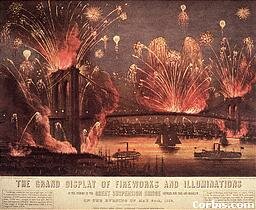
Fireworks Display at Brooklyn Bridge Opening
|
Fireworks Display at Brooklyn Bridge Opening |
"Babylon had her hanging gardens, Egypt her pyramids, Athens her Acropolis, Rome her Athenaeum; so Brooklyn has her Bridge." (1) |
The Building of the Brooklyn Bridge did not come without any complications. The people of Manhattan and Brooklyn did not have complete faith in the new bridge. Rumors spread doubting the physical and mental health of Washington Roebling throughout the completion of his bridge. The bridge took longer than expected to be built, and the community thought this was a signal that there were difficulties pending. Since the Brooklyn Bridge was completed with the help of Roebling's wife, Emily, the public was unsure of the stability of it. They assumed that a woman could not possibly be responsible for the production of a structure as grand as what they saw going up. The Roeblings, on the other hand, had confidence in the monumental bridge. In early May, 1883, Emily Roebling was the first person to cross the completed bridge. "&She and a coachman had crossed over from Brooklyn in a new Victoria, its varnish gleaming in the sunshine. She had taken a live rooster along with her, as a sign of victory, and from one end of the bridge to the other, the men had stopped their work to cheer and lift their hats as she came riding by." (2)
|
 |
|
Opening Ceremonies |
|
Not every aspect of the bridge's launch was successful. During the first week the bridge opened, masses of people used the bridge. Not only was it less expensive and faster than the ferries, but the people who crossed it in that first week felt as though they were making history. On the Sunday after the bridge opened, 163,500 people went strolling across the new bridge. On Thursday, May 31, the misfortune that Washington Roebling cautioned the city about occurred. By mid-afternoon, crowds of pedestrians began to use the promenade. As one large group of people was coming onto the bridge on the New York side, another was trying to leave. When the two oncoming masses met on the stairs, there was chaos, pushing and shoving, while nobody was able to move anywhere. People started to fall and the stampede became worse and worse. By the time it was all cleared up, twelve people had been trampled to death. The explanation for the tragedy is still unknown; there are some beliefs that somebody started screaming that the bridge was falling, and that local "rough kids" started using violence.
|
Panic stricken people on the Brooklyn Bridge, May 30, 1883
|
The disaster on the bridge so soon after the opening day left many people feeling insecure and uneasy about the bridge. As a result, many traffic controllers and policemen were hired in order to bring reassurance to the people. Soon after the summer, train lines were set up across the bridge, and the public forgot about the disaster that had occurred.
1. Sign posted in a Brooklyn shop
2. McCullough, The Great Bridge, page 516-517
3. Sharon Reier, The Bridges of New York, page 23
4. Alan Trachtenberg, Fact and Symbol page 117-118